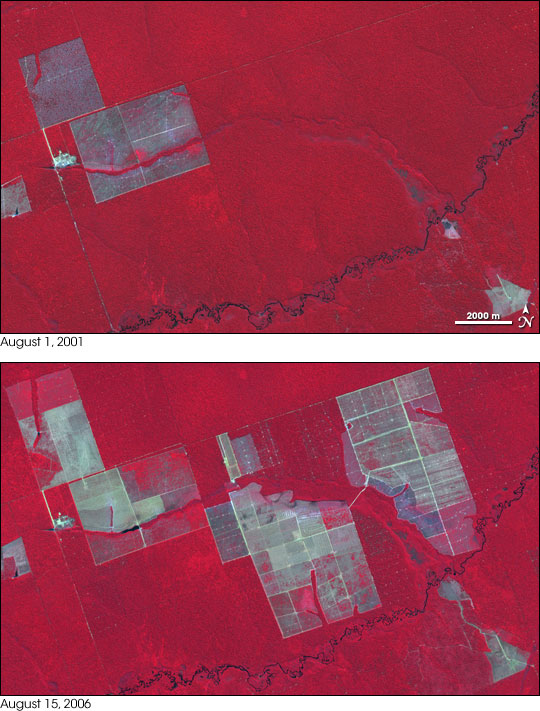


Although forest clearing for pasture is the primary driver of Amazon deforestation in the state of Mato Grosso, Brazil, a new study led by scientists at the University of Maryland showed that large-scale mechanized agriculture, mostly for soybeans, is rapidly becoming a major force behind forest loss in the region. A related study led by scientists at NASA’s Goddard Space Flight Center indicates that what people do with the land—whether they leave it bare, plant crops, or convert it to pasture—influences the climate in different ways.
This pair of images shows large clearings made in the Amazon Rainforest in the state of Mato Grosso, Brazil, between 2001 and 2006. A blue river meanders along the bottom right corner of the images, surrounded by forest, which appears red. In 2001, a few large clearings (blue-gray rectangles) appear on the north and south sides of a road that cuts northeast across the upper left corner of the image. By 2006, the area cleared in the scene appears to have roughly tripled, but the reddish tinge in some of the clearings indicates vegetation of some kind is growing there. In other places, the ground is totally bare. Satellite observations such as these, which are from the Advanced Spaceborne Thermal Emission and Reflection Radiometer (ASTER) on NASA’s Terra satellite, combined with on-the-ground surveys, help scientists monitor forest changes over time.
Using maps, NASA satellite data, and field surveys, scientists from the University of Maryland and some international colleagues studied the fate of cleared forest in Mato Grosso from 2001-2004, and discovered that people cleared more than 540,000 hectares (about 1.33 million acres) of forest for croplands. As significant as the total area cleared is the fact that individual areas cleared for croplands were twice the size of areas cleared for pasture on average, which means that the remaining forest is more fragmented—a handicap for maintaining healthy and diverse ecosystems in the remaining forests.
In a related study, scientists from Goddard Space Flight Center fed satellite data on the area and type of forest conversion in Mato Grosso into computer models to predict the effect on climate. Leaving the ground bare has the most significant influence, raising temperatures up to 3 degrees Fahrenheit. Croplands have the second most significant impact, followed by pastures.
NASA images by Robert Simmon, based on data provided by the NASA/GSFC/METI/ERSDAC/JAROS, and U.S./Japan ASTER Science Team